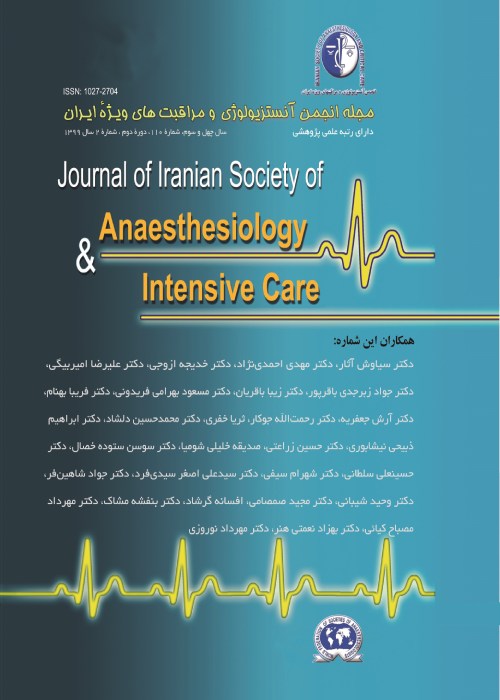Comparison of the preemptive effect of Dexmedetomidine and ketorolac on post operative pain for appendectomy
Author(s):
Article Type:
Research/Original Article (دارای رتبه معتبر)
Abstract:
Introduction
Pain is one of the common complication of surgery. Pain is a complex of physiological responses to tissue injury. Patients worry mostly of how much pain they would experience after surgery. Dexmedetomidine and ketorolac are two drugs that have analgesic effects. The aim of this study is compare the preventive analgesia efficacy of Dexmedetomidine and ketorolac in patients after appendectomy operations
Materials and methods
This study is a randomized double blinded clinical trial. Sixty patients aged 18 to 65 (ASA I-II) who had undergone appendectomy operations with general anesthesia were analyzed. The patients were divided into three groups according to the block randomization table. Group A patients received a bolus intravenous dose of 1 microgram/kg Dexmedetomidine in 10 minutes before induction and a continuous infusion of 0.5 microgram/kg/hr during the operation. Group B received intravenous 30 mg ketorolac before induction. Group C was the control group that received normal saline. An intravenous infusion of normal saline was administered to groups B and C. Induction, maintenance and reversal were same for all study groups patients. At the end of anesthesia, a digital PCA pump containing fentanyl (bolus 10 microgram, lockout time 10 minutes) was applied. Pethidine (25 mg IV) was applied to patients who had intractable shivering. The patients’ vital signs were recorded 5 minutes after resting on the bed of the operating room, immediately after intubation, at 5, 10, 15, 20, 30, 40 and every 10 minutes till the end of operation. The patients’ vital signs, nausea – vomiting and the degree of shivering were all recorded. Pain intensity was recorded by VAS at 1, 3, 6, 12 and 24 hours after operation. In the case of a patient having a VAS greater than 3 and a request for analgesic medication a 100 mg diclofenac suppository was administered. The total volume of PCA consumed by the patients were recorded. The gathered data were statistically analyzed by an SPSS 19 software and P values less than 0.05 were accepted significant.
Results
there is no significant difference between the study groups regarding age, gender, height, weight, ASA classification, nausea-vomiting and shivering. The pain intensity was not significantly different betweem groups at 1, 3 and 6 hours after operation; but in the Dexmedetomidine group it was less than the two other groups at 12 and 24 hours after operation (P12= 0.004 & P24= 0.003). There was no difference between the ketorolac and control group. The total dose of fentanyl PCA used was significantly less in the Dexmedetomidine group compared to the control group (PPCA= 0.003). Body temperature was significantly higher before, during and after operation in the Dexmedetomidine group compared to the two other groups (PT= 0.001). During operation the decrease in body temperature was significant in the ketorolac and control groups (PK= 0.037 & PC=0.001). the changes in blood pressure were not significantly different between the three groups but there was a significant increase in mean arterial pressure (MAP) during the operation time. Heart rate before intubation, at 5, 20, 40 minutes and in the recovery was not significantly different. The heart rate at 10, 15 and 30th minutes was significantly lower in the Dexmedetomidine group compared to the control group (P10=0.022 & P15=0.010 & P30=0.015) and immediately after intubation, 10th minute compared to the ketorolac group (PPO=0.033 & P10=0.024). There was no significant difference between the three groups regarding the changes in SpO2 levels at before, after intubation and at 10th minute after intubation. However, the SpO2 levels were significantly lower in the Dexmedetomidine group compared to the other groups at 5, 15, 30, 40th minutes and recovery time (P5=0.045 & P15=0.006 & P30=0.003 & P40=0.003 PR=0.024). Although the SpO2 levels did not have any significant change during the time within each group.
Conclusion
Dexmedetomidine as an agent for preventing pain after operation is mostly effective at 12 and 24 hours after operation which attenuated the need for analgesic medication postoperatively.Keywords:
Language:
Persian
Published:
Iranian Journal Of Anaesthesiology and Critical Care, Volume:40 Issue: 3, 2018
Pages:
45 to 56
magiran.com/p1957888
دانلود و مطالعه متن این مقاله با یکی از روشهای زیر امکان پذیر است:
اشتراک شخصی
با عضویت و پرداخت آنلاین حق اشتراک یکساله به مبلغ 1,390,000ريال میتوانید 70 عنوان مطلب دانلود کنید!
اشتراک سازمانی
به کتابخانه دانشگاه یا محل کار خود پیشنهاد کنید تا اشتراک سازمانی این پایگاه را برای دسترسی نامحدود همه کاربران به متن مطالب تهیه نمایند!
توجه!
- حق عضویت دریافتی صرف حمایت از نشریات عضو و نگهداری، تکمیل و توسعه مگیران میشود.
- پرداخت حق اشتراک و دانلود مقالات اجازه بازنشر آن در سایر رسانههای چاپی و دیجیتال را به کاربر نمیدهد.
In order to view content subscription is required
Personal subscription
Subscribe magiran.com for 70 € euros via PayPal and download 70 articles during a year.
Organization subscription
Please contact us to subscribe your university or library for unlimited access!


